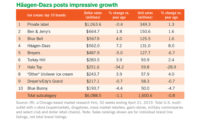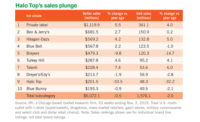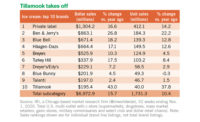Like many other U.S. retail food categories, the ice cream category has been awash with innovation during the past few years. From lower-sugar, higher-protein formulations and portion-controlled offerings to “ice cream” that’s … well … not really ice cream, the sheer number of choices awaiting consumers in the freezer case is somewhat mind-boggling.
Despite all the innovation — or perhaps partly because of it — sales within the U.S. retail ice cream category have been relatively flat in recent years.
“Over the past five years, the category has grown by just 4% in inflation-adjusted figures,” notes global market research firm Mintel in its May 2019 “Ice Cream and Frozen Novelties — U.S.” report.
The Mintel report also states that the category is diverse, crowded and complex — and suggests that some of the innovation occurring is for naught. Case in point: One-fifth of consumers Mintel surveyed indicated they would not be motivated to try a new product if it boasted any one of a number of listed innovations, including new textures, mini sizes, plant-based alternatives, functional benefits and high protein content.
“Consumers overall had fairly lukewarm response to most measures of innovation,” Mintel points out. “New product development will always be a mainstay of the category, but it should be focused on a new generation and always lead with good taste.”
That being said, innovation aligning with trends that have staying power does have the potential to succeed — and boost the category.
Indulgence still rules
Ice cream has always been associated with indulgence, and decadent offerings continue to attract consumers.
“Consumers are paying attention to quality and ingredients; it’s not enough to go on brand name alone anymore,” says Natasha Case, CEO and co-founder of Los Angeles-based Coolhaus. “It’s important to be strategic to dominate your niche, even if it’s well within your category.”
Speaking of decadent offerings, Coolhaus will launch rich-tasting Queens’ Coffee pints, in partnership with Allegro Coffee, in March, she adds.
Also new on the indulgent front is the Häagen-Dazs ruby cacao collection from Nestlé USA, Arlington, Va. The limited-edition line is billed as the first offering of ruby cacao ice cream products in the United States. According to Häagen-Dazs, ruby cacao beans can be found in Ecuador, Brazil and Ivory Coast. The ruby hue and flavor are released during the bean’s unique fermentation process.
The line includes Ruby Cacao Crackle Pistachio Sweet Cream Trio Crispy Layers, featuring crispy ruby cacao layers complementing creamy layers of pistachio and sweet cream ice cream, and Ruby Cacao ice cream bars, featuring sweet cream ice cream dipped in a rich ruby cacao coating with berry fruity notes.
“The Häagen-Dazs brand encourages consumers to indulge in the finest, and the ruby cacao collection is an extraordinary new experience for people to try,” says Rachel Jaiven, Häagen-Dazs brand manager. “The flavor is fresh, fruity and smooth, with an aftertaste of berry and a hint of cacao.”
And Perry’s Ice Cream Company Inc. of Akron, N.Y., just released a premium sundae cake line of ice cream as part of a larger introduction of 20 new products. Flavors include Almond Sundae Cake (almond ice cream with almond-flavored cake crumbles and whipped cream ice cream in the center), Chocolate Sundae Cake (chocolate ice cream with chocolate-flavored cake crumbles and whipped cream ice cream in the center), Strawberry Sundae Cake (strawberry ice cream with vanilla-flavored cake crumbles and whipped cream ice cream in the center) and Yellow Sundae Cake (yellow cake ice cream with chocolate- and vanilla-flavored cake crumbles and whipped cream ice cream in the center).
For its part, Burlington, Vt.-headquartered Ben & Jerry’s recently announced the debut of its indulgence-minded Netflix & Chill’d flavor. Created in partnership with Netflix, the “chillaxing new creation” combines peanut butter ice cream with sweet and salty pretzel swirls and fudge brownie pieces. (It’s available in a nondairy version, too.)
“Whether you’re streaming a laugh-out-loud comedy, an edge-of-your-seat drama, or a ‘hey-I-didn’t-know-that’ documentary, it’s not complete without a tasty treat and a few of your favorite friends,” Ben & Jerry’s says in the press release introducing the product.
Sara Schramm, marketing brand manager for Blue Bell Creameries of Brenham, Texas, says her company’s focus continues to be on new “indulgent ice cream flavors” packaged in full half-gallon cartons.
“Each year, we continue to develop new and exciting ice cream flavors, which help drive our sales and keep consumers coming back to the freezer in search of something new,” she says. “Cookie Cake was introduced in 2019 and became an instant hit with our consumers. It’s a sweet cream ice cream loaded with chocolate chip cookie cake pieces and swirls of chocolate and vanilla ice cream. It was so popular that we’re bringing it back later this year.”
Healthful indulgence wins, too
According to “Ice Cream and Frozen Desserts in the U.S.,” a September 2019 report from London-based Euromonitor International, there’s also a trend toward healthful indulgence in the ice cream segment. But that trend excludes low-fat ice cream, which the market research firm says has largely fallen out of favor with U.S. consumers. More consumers are viewing fat as a neutral or positive attribute.
“Low-sugar products have been exceptionally strong performers in recent years, while the smaller organic segment has achieved consistent double-digit annual sales growth,” Euromonitor states. “At the same time, new and unique variants continuously emerge to popular acclaim, such as ice cream featuring probiotics, an attribute previously associated closest with yogurt.”
Tying into the low-sugar trend is the new Halo Top Keto Series — designed for followers of the ketogenic diet and others who are limiting their sugar intake. The frozen dessert, from the Halo Top brand of Le Mars, Iowa-headquartered Wells Enterprises Inc., is said to deliver the same lower-calorie goodness as previously existing Halo Top flavors, while incorporating creamy ultrafiltered skim milk, which provides fewer calories than regular milk and is a good source of protein.
Net carbs range from 5 to 10 grams, and calories range from 410 to 630 per pint, Halo Top said. Flavors in the new line include Peanut Butter Chocolate, Caramel Butter Pecan, Chocolate Cheesecake, Jelly Donut, Berry Swirl, Banana Cream Pie and White Chocolaty Macadamia Nut.
“Our brand is focused on making delicious desserts that everyone can feel good about eating, and these new flavors allow us to do that for our fans looking to limit their sugar intake,” says Meg Graeff, senior brand manager, Halo Top.
However, Matthew Thornicroft, assistant marketing and communications manager for Cleveland-based Pierre’s Ice Cream Co., notes that even among current trends viewed as better for you — including high-protein, plant-based and more — interest in indulgent-tasting offerings is a common thread. In other words, taste expectations are high.
Frozen yogurt is perceived by most consumers as a better-for-you alternative to ice cream. But Pierre’s tied into the trend of healthful indulgence when it recently added two decadent flavors to its 1.5-quart frozen yogurt line.
The new flavors include Chocolate Monster, which combines chocolate frozen yogurt, brownies, chocolate chip cookie dough and chocolaty chips, and Sea Salt Caramel Toffee Crunch, which marries caramel frozen yogurt with chocolate-covered toffee pieces and sea salt caramel swirl, Thornicroft says.
Downsizing is in
Another way to win is via portion-controlled offerings that tap into consumers’ desire for convenience — and a little help with controlling how much they eat.
The Mintel report notes that surveyed consumers did rank that type of innovation higher than many of the others listed as a potential purchase motivator (only new textures beat it out).
“The importance of portion control and snack-friendly comes through with the second-most selected innovation — mini sizes,” the Mintel report states.
Thornicroft says Pierre’s is seeing growing interest in such items pairing “quality and convenience.” In response, the company introduced 5-ounce Snack Cups — single-serving sizes of four of its popular ice cream flavors: Chocolate Peanut Butter Cup, Coconut Pineapple, Sea Salt Caramel Toffee Crunch and Vanilla. The calorie count ranges from 180 to 220 per cup.
It’s also worth noting that a portion-controlled but decadent ice cream offering — Friendly’s Cake Singles from Dallas-based Deans Food Co. — came out on top in Dairy Foods’ 2019 Best New Dairy Products reader poll. The 8-ounce ice cream cups were created to deliver the same indulgence as traditional Friendly’s ice cream cakes, with added convenience and versatility, Dean Foods said.
They are available in four flavors: Strawberry Krunch, Birthday Cake, Chocolate Krunch and Strawberry Cheesecake.
“With Friendly’s Cake Singles, we saw an opportunity to use the same great flavor combinations that consumers have loved for years and deliver on their desire for more variety and convenience in their sweet treats,” says Mark Schneider, marketing director, ice cream, Dean Foods.
Plant-based is everywhere
Although technically not ice cream, plant-based ice cream alternatives are definitely shaking up the ice cream category. And in many cases, it’s traditional ice cream companies that are introducing these newfangled frozen desserts to meet growing consumer demand.
“There is an increase in flexitarians — these are people who are willing to give plant-based a try and believe those products can be equal and greater in value and taste, if not indulgent and satisfying,” Case explains. “Consumers are also more in touch with their dietary restrictions; that mindfulness has them turning to alternatives.
“Also, we are all more conscious of our impact on the environment,” she adds. “With all of these drivers in play, frozen dessert brands are creating more options, which means a greater likelihood for consumers to find something they love.”
To help meet demand here, Coolhaus soon will be coming out with a line of dairy-free mini frozen dessert cups, she notes. (The ice cream company already offers a number of other dairy-free ice cream alternatives.)
Sean Greenwood, Ben & Jerry’s “grand poobah of PR,” said Ben & Jerry’s has noticed that the most significant amount of growth seems to be occurring in the nondairy segment. So in 2020, Ben & Jerry’s will bring its plant-based frozen dessert count up to 17. These include pints, mini cups and offerings within the company’s franchised Scoop Shops.
The newest plant-based additions from the company include sunflower butter-based pints in “Milk” & Cookies, Crème Brûlée Cookie and Mint Chocolate Cookie flavors; the sunflower butter-based Cold Brew Coffee Fudge Chip flavor, available exclusively in Scoop Shops; and almond-based mini cups in P.B. & Cookies and Caramel Chocolate Chunk flavors.
Perry’s Ice Cream also is responding to the plant-based trend, notes Marissa Wilson, communications manager.
“We launched [the] Oats Cream oat-based dairy-free frozen dessert pint line in 2019,” she says. “Oat ‘milk’ continues to be the hot new product in the dairy-free aisle and is positioned to take over nut milks as the leading alternative. Insights from our product development team revealed that oat texture is more like ice cream, with a milder flavor, allowing for freedom and variety in flavor creation.”
Perry’s will be expanding the line in spring 2020 to include Vanilla and Cherry Fudge flavors, she adds.
Some other companies, meanwhile, are going outside of both nut-based and oat-based to create new alternatives to ice cream. For example, Pasadena, Calif.-based Frill — a brand of Zendegii Frill Ltd. — recently created what it calls the first whole fruit- and vegetable-based dairy-free frozen dessert. Made with nothing but whole fruits, vegetables and natural ingredients such as cinnamon and elderflower, Frill is said to be a creamy and clean ice cream alternative.
It is vegan, gluten-free, non-GMO, kosher and paleo diet-friendly. It contains no added sugar, sweeteners or artificial ingredients. Instead, Frill derives its sweetness from the natural sugar in dates and whole fruits, resulting in half the sugar of traditional ice cream and 10 times the fiber. The offering also has only 70-100 calories per serving and is available in Bursting Berries, Intense Chocolate, Nutty Caramel and Refreshing Green flavors.
Go beyond formulation trends
Increasingly, players within the ice cream space need to think about more than on-trend formulations to win. One consideration that’s becoming more important among today’s consumers, Greenwood says, is responsible sourcing.
“Ben & Jerry’s fans like to hear about our efforts at sustainability for farms with our Caring Dairy program, fairtrade and non-GMO sourcing practices and purchasing ingredients from vendors who do good things in the world,” he notes.
Ice cream processors also need to put more thought and effort behind merchandising and marketing, Case suggests.
“We have to think deeply about how to make merchandising that pops behind a fogged-up freezer door that has tags all over it,” she stresses. “Amongst new competitors in the category, how are you thinking about brand awareness and telling your story? This matters especially if you’re not in e-commerce. It makes digital marketing challenging, but it’s also where you’re seeing some very creative campaigns as a result.”









